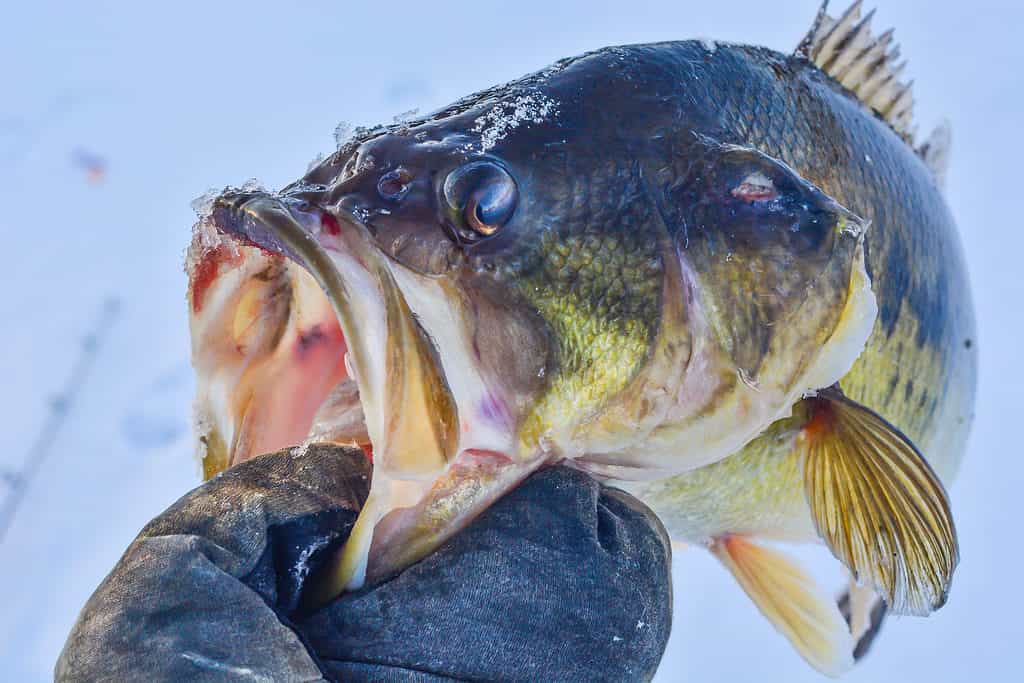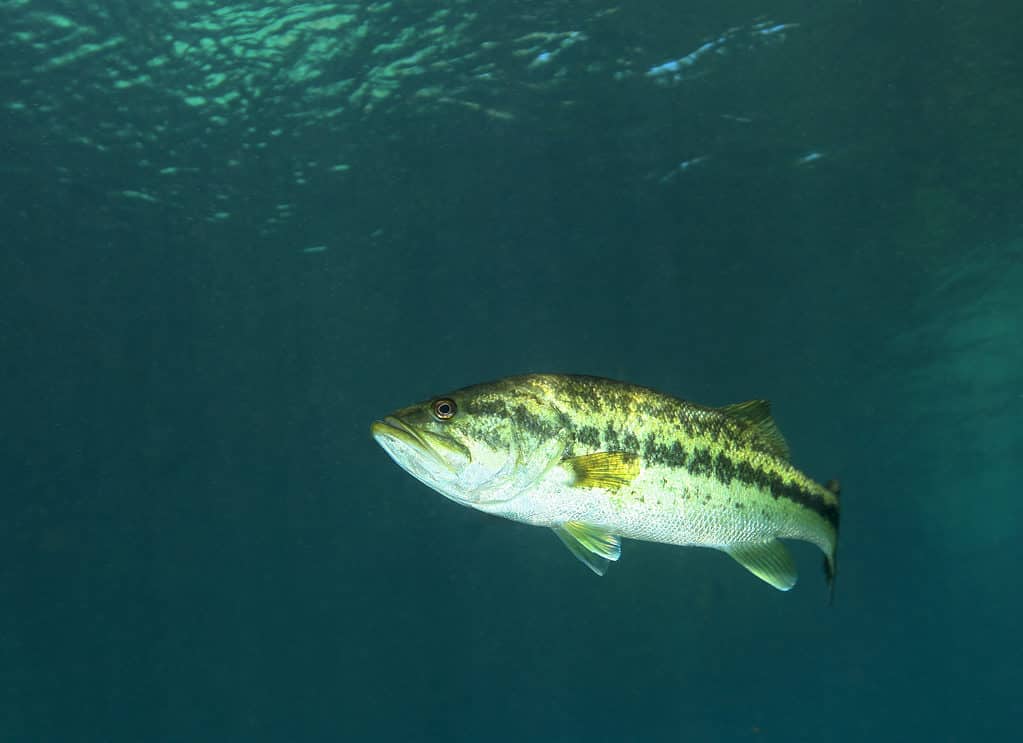The largemouth bass is among the most popular recreational fish in the United States. Many largemouth bass fishing contests are hosted across the country, and as a result, they have been stocked to provide recreational fishing possibilities. For many of us, largemouth bass fishing is more than just a recreational activity. Any angler would be lying if they said they haven’t dreamed of capturing a big fish, whether it’s a ten-pounder or a state record.
Breaking the world record may be a pipe goal, but breaking any large bass record is an adventure worth pursuing. If catching the next world-record largemouth bass is your goal, Illinois waters can be a challenging choice. Why is that? How big is the Prairie State’s record largemouth bass? This article uncovers the largest largemouth bass caught in Illinois and other interesting facts.
What Is the Largest Bass Caught In Illinois?

Illinois’ largemouth bass state record was set in February 1976 at Stone Quarry Lake
©iStock.com/michaldziki
In February 1976, the state record for largemouth bass was set in Illinois. Edward J Walbel caught the big bass in Stone Quarry Lake, which weighed 13 pounds, 1 ounce. That’s nine pounds short of George Perry’s world record 22-pound, 4-ounce lunker taken in Georgia in 1932.
As previously said, catching a large fish in Illinois can be difficult. But how did a 13-pound bass end up in its waters? The people of Illinois are divided about the current state record. Some argue that a 13-pound largemouth could only have come from northern Illinois if DNA testing proved it. To put it another way, a 10-pound largemouth is so unusual in Illinois that a 13-pounder seems to be unbelievable. On the other hand, the state record is possibly legitimate. Although extremely unlikely, it is possible.
How Do You Identify a Largemouth Bass?

Largemouth bass can grow up to 30 inches long.
©iStock.com/stammphoto
The olive color of the largemouth bass is a surefire way to identify this fierce fighter. It has a series of black blotches running down its side, forming a jagged horizontal line the length of its body. It is the largest of the black basses, reaching about 30 inches in length and weighing nearly 25 pounds based on the largest recorded size! The most important thing to remember is that their upper jaw extends behind the eye, which can help distinguish a largemouth bass from a spotted bass or other similar-looking fish.
What Does a Largemouth Bass Eat?

Mice occasionally feature on the menu of largemouth bass
©Pacific Southwest Region USFWS/CCBY2.0 – Original / License
Largemouth bass are natural predators in several lakes and opportunistic feeders. They consume their prey whole and eat a diverse range of food. Adult largemouth bass eat fish, crayfish, and frogs, and the young rely on crabs, insects, and small fish. Largemouth bass are voracious eaters, preying on a variety of species, even terrestrial animals like snakes and mice.
Where in Illinois Can You Find Largemouth Bass?

Largemouth bass can be found in small, shallow lakes.
©Ryno Botha/Shutterstock.com
The largemouth bass is the most common of the black basses and can be found across Illinois. The largemouth favors shallow, weedy lakes and river backwaters, which are home to bluegills. Bass can also inhabit small bodies of water such as lakes or ponds.
During the day, largemouth bass are attracted to structures and can be found under lily pads or laying in the shade of overhanging trees, piers, or vegetation. They frequently move into shallow water in the evening and stay until after sunrise to feed before retreating to deeper water or shade for the rest of the day. Largemouth bass can withstand high temperatures but prefer deeper, colder waters in the summer.
The Best Lakes in Illinois for Bass Fishing

There are several lakes in Illinois in which bass can be found
©iStock.com/ScottrBennie
While several bodies of water in Illinois produce huge bass most of the time, the ones listed below are noted for regularly yielding large numbers of bass, which is why they’re ranked as the finest bass lakes in Illinois.
1. Newton Lake
Newton Lake has a thriving bass population in the two to six-pound range, with larger bass caught occasionally. The hydroelectric lake in Southeast Illinois has a 25-hp limit, reducing fishing pressure.
2. Braidwood Lake
Braidwood Lake is a small lake with much access to shorelines, and this popular lake near Chicago regularly produces largemouth fish weighing up to ten pounds. Most habitats comprise steep drop-offs, rock piles, man-built habitats, and wooded cover. Boating on this lake is dangerous, and extreme caution is advised.
3. Lake Shelbyville
Lake Shelbyville, in east-central Illinois, is well-known for its largemouth bass population. The above-average sizes provide a real chance to catch trophy bass weighing up to ten pounds. This lake hosts several bass tournaments due to the consistent amount and size of largemouth bass.
How Long Do Largemouth Bass Live?

Largemouth Bass can live for up to a decade
©iStock.com/mpwoodib
Two years after they hatch, largemouth bass become capable of reproducing the next generation. However, they only get to live for eight or ten years after that. Meaning they have a lifespan of 10 or 12 years. Which isn’t that long compared to other well-known species such as catfish which are capable of living for as long as six decades, or even surgeons which are capable of making it to 100 years.
What Is the Biggest Fish Caught in Illinois?

The largest fish ever caught in Illinois was a sturgeon, 80 years ago
©Leonid Eremeychuk/Shutterstock.com
A lake sturgeon from Lake Michigan was the largest fish ever caught in Illinois waters in 1943. The fish weighed 310 pounds and measured 7 feet and 11 inches in length.
Unfortunately, the lake sturgeon is endangered in Illinois due to the fish’s inability to access upstream spawning areas due to dam building and the degradation of spawning areas by channelization, impoundment, siltation, and pollution. Too much fishing in the late 1800s and early 1900s also contributed to the problem.
Thank you for reading! Have some feedback for us? Contact the AZ Animals editorial team.








